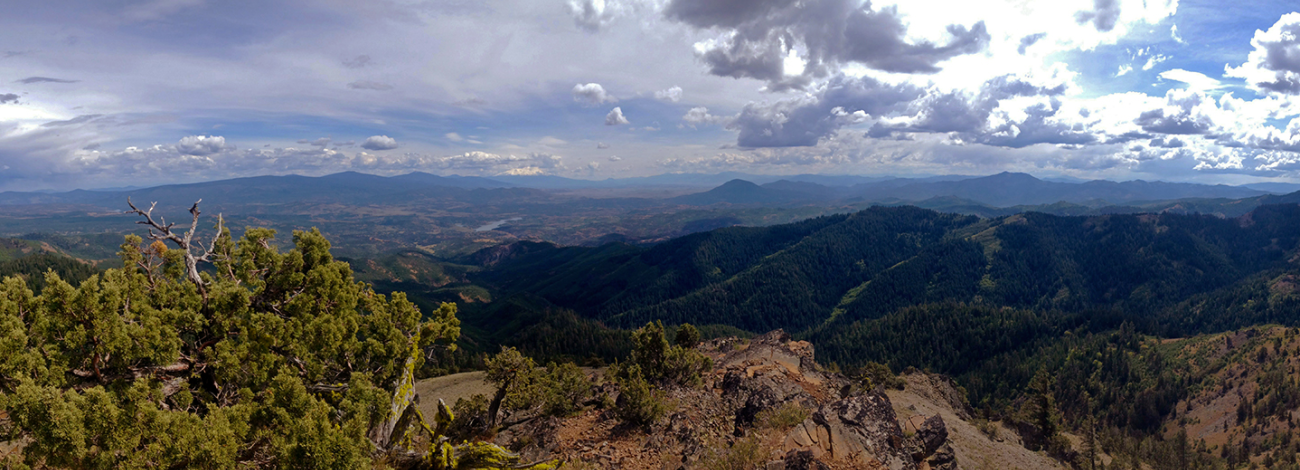
Soda Mountain Wilderness Area
The United States Congress designated the Soda Mountain Wilderness in 2009 and it now has over 24,700 acres. All of this wilderness is located in Oregon and is managed by the Bureau of Land Management (BLM).
The Soda Mountain Wilderness in southwestern Oregon is an ecological mosaic where the state's eastern desert meets towering fir forests. Prior to designation as wilderness, the Clinton administration designated 53,000 acres of federal land in the area as the Cascade-Siskiyou National Monument in June 2000 to protect this extraordinary biological reserve.
The Soda Mountain Wilderness encompasses the rich biological and geological diversity in the mountains southeast of Ashland, Oregon. The new wilderness lies on the south side of the Medford District. The heart of the wilderness is the 5,720-foot high Boccard Point where the great basin meets three mountain ranges. The older Klamath Range comes up from the south while the much younger Siskiyou Range extends from the west. Jutting up from the north is the very young Cascade Range.
All of this beauty and diversity awaits YOU!
- Directions
-
The Cascade-Siskiyou National Monument and the Soda Mountain Wilderness is located immediately north of the California/Oregon border near Interstate 5. The easiest access is Hwy 66 near the town of Ashland, Oregon.
Scattered parcels of private land are interspersed with monument lands and at times the Pacific Crest National Scenic Trail passes through private lands with permission of the land owners. Please stay on the trail when passing through private land.
Hiking is one of the best ways to explore the Soda Mountain Wilderness Areas' ecological diversity. The Pacific Crest National Scenic Trail provides the easiest access for day hikers and is the only designated trail in the monument. A hike along the Pacific Crest National Scenic Trail winds through oak woodlands, old-growth ponderosa pine and Douglas-fir forests, grasslands, and ceanothus-filled shrub-lands. Cross country exploration by foot or on horseback is allowed in Cascade-Siskiyou NM and the Soda Mountain Wilderness. Please follow Leave No Trace principles.
- Know Before You Go
-
From October to April, the Cascades and the Siskiyous bring moisture from Pacific storms, resulting in snow covered mountains in the higher elevations (above 3500 feet) to rain in the valleys. Depending upon the year and number of storms, snow can blanket much of the Monument's mountains well into May. Hiking and access to popular trails such as Pilot Rock, Hobart Bluff or parts of the Pacific Crest Trail may not be possible until late May or early June. Winter weather can vary greatly across the monument, due to the diversity of aspect and elevation of the terrain. It may be snowing at the Green Springs Summit, raining at the Emigrant Road Trailhead and be overcast and comparatively balmy at the former Box O Ranch.
From May to September, rainfall tapers off and a drying trend begins with warmer days. Many areas of the Monument are still covered in snow and may not be entirely accessible during the month of May and into June. Summer months are normally warm and dry with daytime mountain temperatures reaching the 80s - 90s in mid-summer, while night time temperatures cool down to the upper 40s-mid 50s. Lower elevation south facing exposures have been known to reach a 100 degrees and above some years.
Visitors can help in protecting this fragile ecosystem by adequately planning and by arriving prepared! Knowledge of the area, weather, terrain, and common sense can help to ensure you have a safe, fun, and memorable trip to the wild. Trail junctions are generally unsigned, so you should carry a map and a compass. And always be sure to bring your ten essentials!
- Management Background
-
The Soda Mountain Wilderness is part of the 110 million acre National Wilderness Preservation System. This System of lands provides clean air, water, and habitat critical for rare and endangered plants and animals. In wilderness, you can enjoy challenging recreational activities like hiking, backpacking, climbing, kayaking, canoeing, rafting, horse packing, bird watching, stargazing, and extraordinary opportunities for solitude. You play an important role in helping to "secure for the American people of present and future generations the benefits of an enduring resource of wilderness" as called for by the Congress of the United States through the Wilderness Act of 1964. Please follow the requirements outlined below and use Leave No Trace techniques when visiting the Soda Mountain Wilderness to ensure protection of this unique area.
Unless otherwise specified, no motorized equipment or mechanical transport, with the exception of wheelchairs, is allowed. This is generally true for all federal lands managed as designated wilderness.
- Planning
-
In April 2012, the final Soda Mountain Wilderness Stewardship Plan was completed. The Soda Mountain Wilderness was added to the National Wilderness Preservation System by the Omnibus Public Land Management Act of 2009 (Public Law 111-11, March 30, 2009). Public Law 111-11 designated 24,100 acres of the Cascade-Siskiyou National Monument (CSNM) as wilderness.
This plan provides the primary guidance for managing the Soda Mountain Wilderness (SMW). This wilderness stewardship plan is an implementation-level plan that provides a set of decisions outlining management of the SMW over the next 10 years. These implementation actions are designed to meet the wilderness management goals and objectives and respond to those wilderness specific issues which were identified through scoping.
The Final SMW Stewardship Plan focuses on enhancing wilderness character and values through a combination of actions that would include active and passive restoration as well as providing opportunities for solitude and primitive recreation including some roads to trails conversions. Restoration activities include culvert removals; former vehicle route recontouring; removal and restoration of water developments; and removal of selected structures, fences, cattle guards, and other evidence of human influence. Download a copy of the Soda Mountain Wilderness Stewardship Plan.
